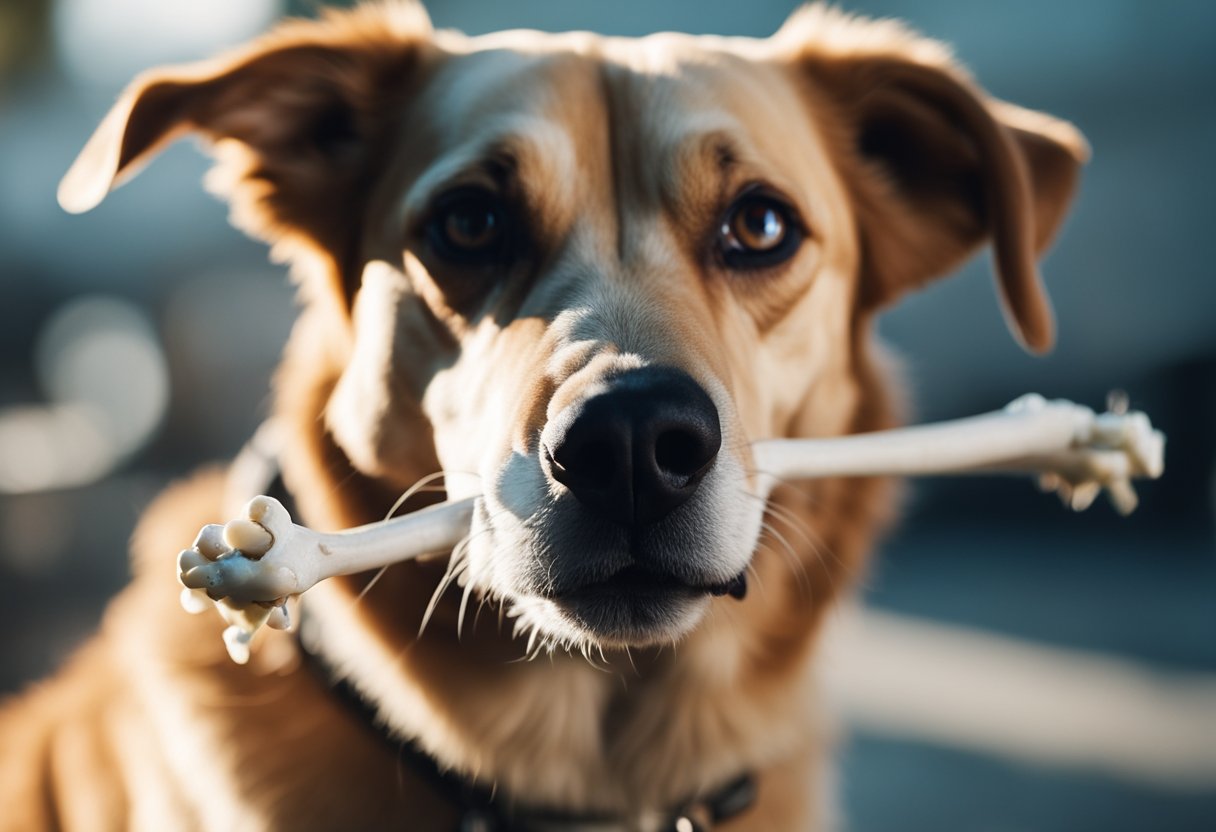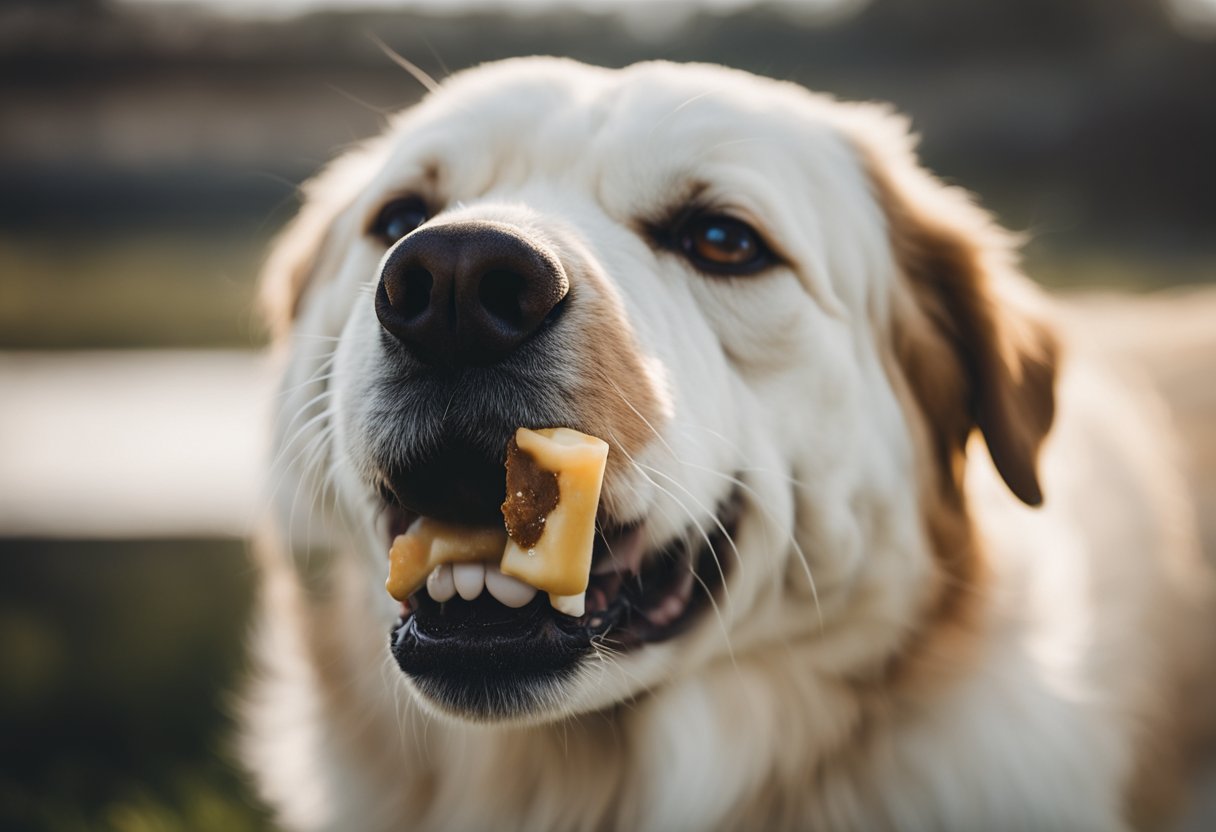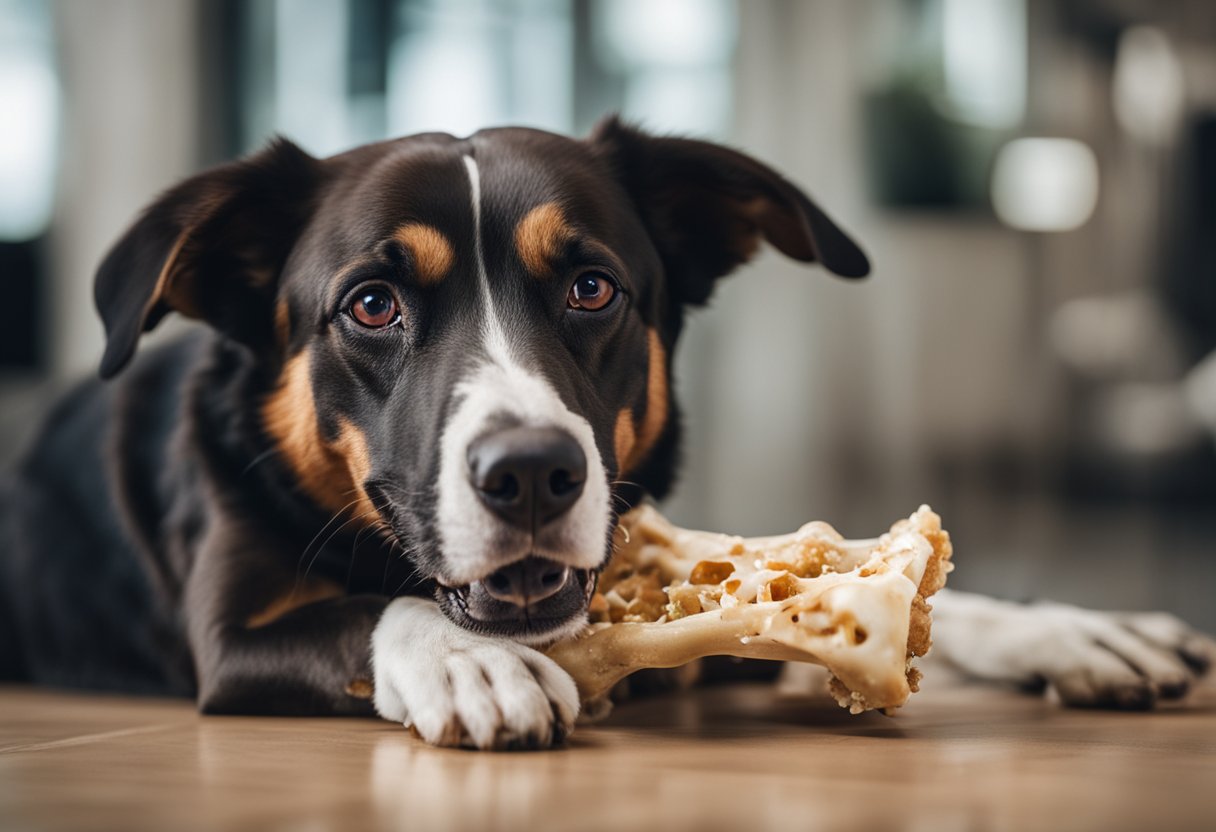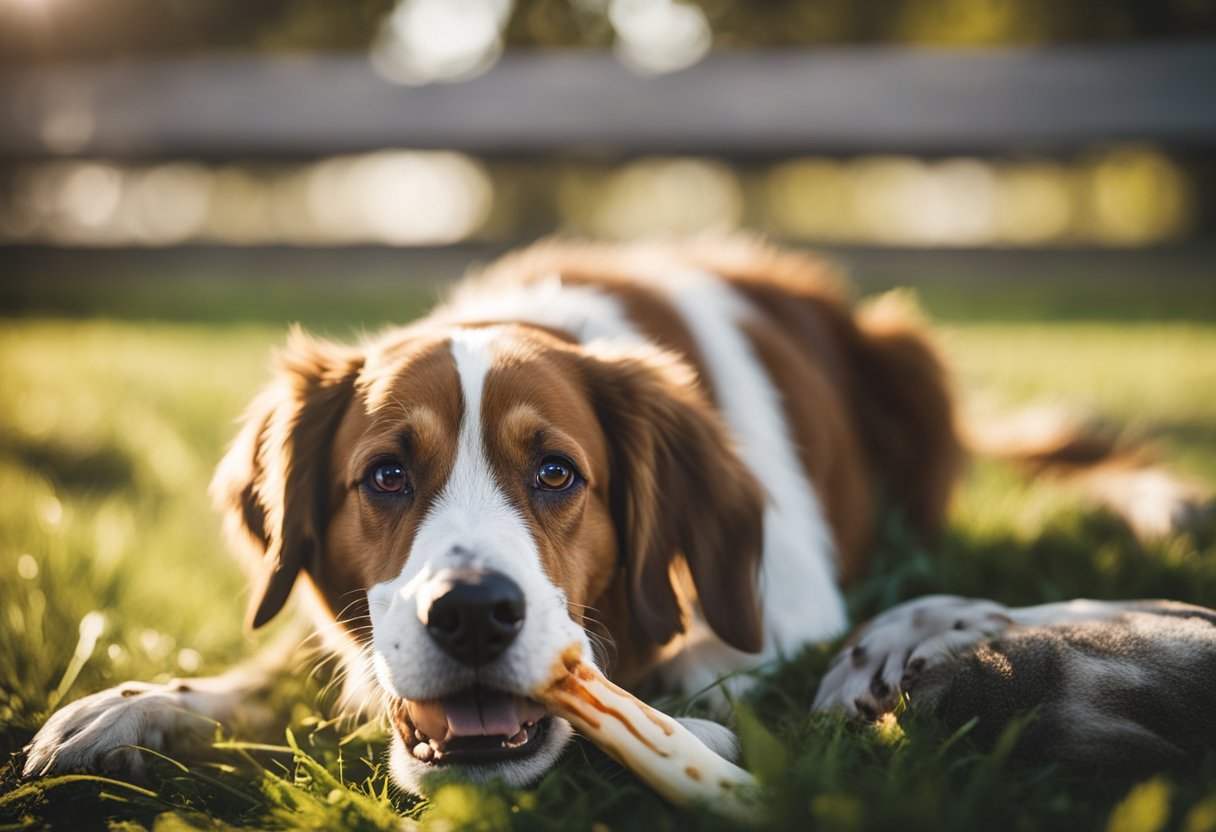Observing your dog’s gums bleeding while they are gnawing on a bone can be an alarming sight for any pet owner. This situation might raise concerns about your pet’s oral health and prompt questions about whether this is normal behavior or a sign of an underlying problem.
While it is not uncommon for some dogs to experience minor gum bleeding, particularly when chewing on hard objects, consistent or heavy bleeding could indicate dental issues or gum disease.
It’s important to pay close attention to your dog’s oral health, as it can have a significant impact on their overall well-being.

Understanding the causes behind bleeding gums in dogs is essential for addressing this issue effectively. Common reasons might include the natural teething process in puppies, abrasive chewing on hard bones or toys, or more serious health conditions such as periodontal disease.
It is critical to discern between harmless and serious causes of gum bleeding to ensure that your dog receives the appropriate care. Regular dental checkups and proper oral hygiene practices are paramount in preventing gum diseases and ensuring the longevity of your dog’s dental health.
Key Takeaways
- Bleeding gums in dogs can occur due to various reasons, from normal chewing to dental issues.
- Consistent or severe gum bleeding warrants a veterinary consultation to rule out serious conditions.
- Maintaining oral hygiene and regular dental care is crucial for preventing gum disease in dogs.
Understanding Canine Oral Health
A dog’s oral health is a critical aspect of their overall well-being. It encompasses the integrity of their teeth, gums, and the entirety of their mouth. Good oral hygiene practices can help in the prevention of several dental issues and contribute to a longer, healthier life for your canine companion.
Anatomy of Dog’s Mouth
The mouth of a dog is a complex structure composed of teeth, gums, and soft tissues, all of which function together for optimal health. Dogs have 42 teeth, which include incisors, canines, premolars, and molars designed for tearing and grinding food. The enamel covering the teeth is the hardest substance in the dog’s body, protecting each tooth from daily wear and tear. The gums, or gingiva, are the soft tissues that provide support and nourishment to the teeth.
Common Dental Issues in Dogs
Dental problems in dogs can range from mild to severe, affecting different parts of their oral anatomy. One of the most common conditions is gingivitis, which is the inflammation of the gums caused by the buildup of plaque. If not addressed, gingivitis can progress to periodontal disease, a more serious condition that may lead to tooth loss and systemic health issues. Tartar accumulation, a hardened form of plaque, along with bad breath, can also indicate underlying oral health troubles. In some instances, oral health problems can escalate to oral cancer, which requires immediate veterinary attention.
The Relationship Between Chewing and Oral Health
Chewing is a natural behavior for dogs that has a direct impact on their oral health. When dogs chew, it helps to scrape away plaque and reduce tartar buildup, which is essential for maintaining healthy gums and teeth. However, aggressive or improper chewing on hard objects, like bones, can cause symptoms of bleeding gums or damage to the enamel. Providing appropriate chewing toys and routinely engaging in teeth cleaning practices can significantly contribute to the preservation of a dog’s dental hygiene.
Causes of Bleeding Gums in Dogs
Bleeding gums in dogs can stem from various causes, from oral health issues to their chewing habits. Identifying the root cause is important for the well-being of your canine companion and often requires a veterinary consultation.
Gum Disease and Gingivitis
Gum disease in dogs, also known as periodontal disease, is typically caused by the accumulation of plaque and tartar, which is densely populated by bacteria. As these build up on the teeth, they can cause inflammation and gingivitis, an early stage of gum disease characterized by red, swollen gums that may bleed during chewing. If left unchecked, this can progress to more serious conditions affecting the structural support of the teeth. Regular brushing can reduce the chances of such conditions and is particularly advised for breeds with a genetic predisposition to oral diseases.
Diet and Chewing Habits
The diet of a dog and what they chew regularly can influence their oral health. Frequent chewing on hard bones or objects can cause the gums to bleed. Using items like rawhide or dental chews is beneficial, as they are designed to promote dental health. However, dogs should be supervised with these to prevent them from biting off large pieces that might cause injuries. Dogs should have access to appropriate chew toys that do not damage their gums or teeth.
Trauma and Injuries
Trauma or injuries to the gums can result from chewing on objects that are too hard or sharp, such as certain types of chewing bones or objects found around the home. These injuries may lead to bleeding and can become infected if not treated promptly. It’s important to choose toys and chews that match your dog’s size and chewing strength to minimize the risk of oral injuries.
Diagnosis and Treatment Options
When a dog experiences bleeding gums while chewing on a bone, it is important to consult a veterinarian for an accurate diagnosis and to explore treatment options that can alleviate the issue and prevent further complications.
Diagnosing Gum Bleeding Issues
A veterinarian will start with a thorough mouth examination to identify the cause of bleeding gums in dogs. This may involve dental x-rays or a CT scan to assess the health of the teeth and gums beneath the surface. In some cases, a biopsy may be required if oral tumors are suspected. The prognosis will depend on the underlying cause, which can range from dental disease to systemic disorders.
Professional Veterinary Treatment
The professional treatment administered by a veterinarian may include a dental cleaning under anesthesia to remove plaque and tartar buildup. If the bleeding gums are caused by infection, antibiotics may be prescribed. Surgical removal might be necessary for severe cases such as oral tumors, followed by treatments like chemotherapy. A veterinary dentist specializes in providing advanced dental care which may be advisable in certain cases.
Home Care and Management
A caregiver’s role in managing a dog’s oral hygiene is crucial. Regular brushing with veterinary-approved toothpaste, offering dental treats, and ensuring a balanced diet contribute to the overall dental health of the dog. In addition to professional veterinary care, meticulous home dental care helps treat and prevent bleeding gums in dogs.
Signs and Symptoms to Watch For

When your dog exhibits any change in behavior or physical condition, it’s crucial to pay close attention. Persistent symptoms, especially when involving the mouth, can indicate a health issue that might require a veterinarian’s attention.
Identifying Bleeding Gums
Bleeding gums in dogs can often be seen during or after they chew on hard objects, such as bones. Symptoms of bleeding gums include visible blood on toys or bones, or redness around the gums. If you notice your dog’s gums bleeding regularly, this is a persistent sign that should not be ignored.
Other Oral Health Symptoms
In conjunction with gum bleeding, be watchful for signs of oral discomfort or pain. These may include difficulty eating, especially dry kibble, bad breath (halitosis), and loose teeth. Other symptoms such as weight loss, excessive panting, or drooling could also accompany dental issues. These symptoms are indicators that your pet’s oral health should be evaluated by a professional.
Preventative Measures for Healthy Gums

Maintaining healthy gums in dogs is crucial for their overall well-being. Preventative measures can safeguard against gum problems, such as bleeding when chewing on bones.
Choosing Appropriate Chew Items
Selecting safe chew items is pivotal for your dog’s oral health. Opt for dental chews that are specifically designed to reduce tartar and plaque buildup without harming the gums. Avoid hard items that can cause damage, such as bones and antlers. Rawhide treats can be problematic, as they can lead to choking or blockages; digestible options are preferable. Always monitor your dog to ensure they are not chewing aggressively or on items that could splinter and injure their gums.
Routine Dental Care
Committing to routine dental care is a cornerstone of preventing gum bleeding. This care includes regular teeth cleaning by providing a diet that supports oral hygiene and using treats that help clean teeth through natural chewing action. Daily brushing with a canine toothbrush and paste can significantly reduce the risk of gum disease by removing plaque before it hardens into tartar. Periodic professional dental cleanings by a veterinarian can catch early signs of gum disease and prevent progression. Remember, a combination of home care and professional oversight will provide the best protection for your dog’s dental health.
Special Considerations for Specific Dog Breeds

When considering gum bleeding in dogs, it’s important to recognize that certain dog breeds may be more genetically predisposed to oral health issues. Understanding these risks can guide caregivers in providing appropriate care.
Breed-Specific Oral Health Risks
Dachshunds, along with other small breeds, are often at a higher risk for periodontal disease due to the closer spacing of their teeth which facilitates plaque buildup. Caregivers should remain vigilant for signs of oral health problems in these breeds, such as gums bleeding when chewing on hard objects. Dogs that are predisposed to dental issues may require more frequent dental check-ups and cleanings.
- Genetic Predispositions:
- Small breeds: greater risk for plaque accumulation and periodontal disease.
- Large breeds: may encounter issues from aggressive chewing leading to gum injury.
Careful monitoring and timely veterinary intervention can mitigate these breed-specific oral health risks.
Understanding Growth and Teething in Puppies
Puppy teeth, also known as deciduous teeth, typically erupt around three to six weeks of age. As puppies grow, their teeth can cause discomfort and lead to increased chewing activity, which might result in bleeding gums. It’s crucial for caregivers to provide suitable chew toys that allow for safe teething without harming their gums.
- Teething Phase:
- Starts at 3-6 weeks old.
- Replacement with adult teeth occurs around 3-7 months.
During this phase, puppy-specific dental care is important as it sets the foundation for long-term oral health. Caregivers are encouraged to establish a dental care routine early to prevent any long-term complications associated with gum bleeding or dental disease.
Frequently Asked Questions
When a dog’s gums bleed while chewing on a bone, it often raises concerns for pet owners. This section addresses common questions and provides straightforward guidance on managing and preventing gum bleeding.
What are common causes of gum bleeding in dogs?
Gum bleeding in dogs may occur due to various reasons including dental diseases like gingivitis or periodontal disease, injury from chewing hard objects, or the presence of foreign bodies in the mouth.
How do you treat a dog with bleeding gums?
Treatment for a dog with bleeding gums often involves professional dental cleaning, restorative dental work if necessary, and sometimes antibiotics or anti-inflammatory medications to address underlying infections or inflammation.
What can be done at home to help a dog with bleeding gums?
At home, owners can support their dog’s dental health by providing appropriately sized chew toys to reduce plaque buildup and by following a routine of regular teeth brushing with toothpaste formulated specifically for dogs.
What symptoms besides bleeding might suggest dental issues in dogs?
Other symptoms that may indicate dental problems include bad breath, reluctance to eat, pawing at the mouth, and visible tartar on the teeth. These can suggest the need for a dental checkup.
How can brushing a dog’s teeth lead to bleeding gums, and how to prevent it?
Brushing a dog’s teeth too hard can cause gum bleeding. To prevent this, use a soft-bristled toothbrush and gentle motions. If bleeding persists, consult a veterinarian as this could be a sign of dental issues.
At what point should a dog with bleeding gums be taken to a vet?
If gum bleeding is persistent or accompanied by other symptoms, such as changes in behavior or eating habits, it is important to consult with a veterinarian promptly to determine the cause and appropriate treatment.

